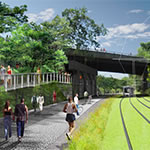Of all the rail-to-trail projects undertaken in recent history, the BeltLine is perhaps the most ambitious. Initially envisioned in 1999 as a transit solution for the notoriously auto-centric Atlanta, the BeltLine vision has kept growing ever since. Today, the sheer scope of the project is probably best comprehended in numbers: It includes four abandoned rail beds transformed into 22 miles of streetcar transit and bike and pedestrian paths. This greenway circles the urban core and connects 45 historic neighborhoods and more than 20 parks. To do it, 1,000 acres of brownfields will be remediated, and 3,000 acres of impervious surfaces will be broken up and given back to native plants. The result is more than 1,300 acres of green space, increasing the city’s parkland by 40 percent.

The BeltLine’s master plan includes a combined 22 miles of streetcar transit and bike paths, which will reduce the city’s dependency on automobiles.

Ryan Gravel, now a senior urban designer with Perkins+Will, first proposed the idea of integrating a light-rail into Atlanta’s transit system while still a student.
And that’s only the beginning. A new 63-mile streetcar or light-rail network, integrated with the BeltLine and existing transit, would serve the greater Atlanta region’s five million citizens. The project’s master plans—10 in all—make way for 46 miles of new streets leading to the greenway, 5,600 affordable housing units, and up to 30,000 total housing units. The project has also promised to create about 30,000 permanent and 48,000 construction jobs and shake up $10 billion in economic development. It’s a plan 16 years in the making with at least 16 to go, at a cost of more than $4 billion in public and private funding. It’s expected to see 1,000,000 visitors annually.

The project’s master plans—10 in all—make way for 46 miles of new streets leading to the greenway, 5,600 affordable housing units, and up to 30,000 total housing units. The project has also promised to create about 30,000 permanent and 48,000 construction jobs and shake up $10 billion in economic development.
So, you can see why Paul Morris is completely serious when he says, “This is one of the most ambitious social experiments going on in the country.” Morris came onboard as president and CEO of Atlanta BeltLine, Inc., the private nonprofit set up to oversee and manage the project, in 2013. The project’s inception, however, was nearly 15 years before, when an architecture student at Georgia Institute of Technology wrote a master’s thesis entitled, “Belt Line–Atlanta: Design of Infrastructure as a Reflection of Public Policy.” That student was Ryan Gravel, today a senior urban designer at Perkins+Will, the firm that made the corridor design a reality. In his thesis, Gravel challenged the city’s reliance on the automobile and proposed to upend that norm by creating light-rail stations along historic freight lines to connect with bus routes and MARTA, the city’s plus-sign-shaped skeleton of a transit network. Still a central tenet of the project, the transit system is currently in the permitting phase.

Green spaces added as a part of the BeltLine, such as Historic Fourth Ward Park, opened in 2012, will increase the city’s parkland by 40 percent.

“You can see that it’s tapped a nerve in the social dynamics of the city,” says Paul Morris, CEO of Atlanta BeltLine, Inc. “You go to the Eastside Trail today and see people of every age, ethnicity, and income. This could be the thing that brings us all together.”
Passing as it does through every quadrant of the city, the BeltLine strives to touch on every definition of sustainability, which is fitting. From citizen health initiatives to off-the-grid solar-powered parks, locally sourced materials, artwork made from salvaged rails and ties, and 50-year life-cycle minimums, the BeltLine is changing what it means to live in Atlanta. Perhaps the most important measure of this is how it literally crosses barriers, dividing a historically segregated city.
“That was the legacy that prevailed for decades,” Morris says. “But the BeltLine took the corridor that was a dividing line and decided that it would be a uniting line. You can see that it’s tapped a nerve in the social dynamics of the city,” he continues. “You go to the Eastside Trail today”—a 2-mile portion of the corridor completed in 2012—“and see people of every age, ethnicity, and income. This could be the thing that brings us all together.”
Click through the other four linear parks below.





